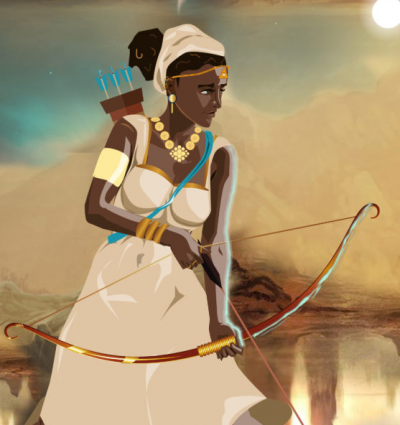Sudanese history recounts a brilliant era when women took the helm in leading the three Kushite kingdoms in the central Nile Valley: Kerma, Napata, and Meroë. Around 40 BC, following the death of the Nubian king Taritikas, the name of his wife shone in a kingdom that witnessed a prosperous era, reliant on wealth from gold, ivory, ebony wood, bronze, iron, and hard wood, along with slave trade with neighboring states. While overseeing the upbringing of her son, Prince Akinidad, she assumed leadership, marking a period in history featuring one of the brightest women who fought the darkest battles and confronted the arrogance of Roman kings, particularly the ruler Julius Caesar. She is Queen Amanirenas, "the woman with the wounded eye," who excelled in strategies of war, peace, and negotiations, and possessed the cunning and resilience to bear the title of kandaka, meaning ruler or queen.
**Kingdom and Queen**
The Kushite civilization in the northern Sudanese Nile Valley was established around 1070 BC, following the collapse of the Bronze Age and the disintegration of the New Kingdom of Egypt. Initially, Kush was centered in Napata (now Karima in Sudan). It is said that its control extended into Upper Egypt, as Kushite kings ruled as Pharaohs of the 25th dynasty in Egypt for about a century before being expelled. The kingdom, renowned for its economic prosperity, relied on an internal system of redistribution, where the state collected taxes and redistributed them to the people. Externally, it served as a connection to trade routes through the Red Sea. In 780 BC, the capital moved to Napata, then to Meroë in 591 BC, where the summer rain belt lay, marking 350 AD as a period of decline for the Kushite civilization but not overshadowing the golden historical legacy of the reign of Kandaka Amanirenas.
**The Kandaka**
Kandaka Amanirenas ruled the Meroitic Kush Kingdom following her husband Taritikas from 30 to 10 BC, coinciding with Cleopatra's rule in Egypt and Mark Antony's in Rome. During this time, the Romans occupied Egypt and expanded their armies southward into the borders of the Kush Kingdom (Nubia), eventually reaching Meroë, where they imposed high taxes that exhausted its people. Despite the prosperity of the Kushite kingdom, which witnessed the construction of around 200 pyramids and developed social systems and lifestyles, Queen Amanirenas understood that any reckless military move against the Roman armies could threaten her kingdom's survival. She held back until the Roman campaign against the Arabian Peninsula and the Hijaz began, at which point her army of 30,000 warriors attacked what remained of the Roman army on her lands.
**Victory and Defeat**
In that battle, which she personally led, the kandaka lost one of her eyes, but her injury did not deter her from fighting, inflicting a significant defeat on the Roman legions, even capturing Aswan, Sinai, the island of Philae, and other territories, along with valuable spoils, including a statue of Roman Emperor Augustus Caesar. According to historical tales, in a twist of fate against women, Amanirenas cut off the head of the statue and buried it under the steps of a temple, allowing the Kushites to step on it while entering and exiting, as an insult to the Roman Empire and Augustus. However, she treated her prisoners well, forbidding their torture, humiliation, or beating, instead using them in temples and royal palaces, some of whom received education in religion and astronomy.
**The Emperor and a Gift of Peace**
When Emperor Augustus learned of what the kandaka had done with the statue's head, he became furious and ordered his soldiers in Egypt to retaliate, leading to the Roman-Meroitic War, which lasted for four years, depleting both armies, which recorded gains and suffered losses. To avoid further losses, Kandaka Amanirenas sent her envoy to the Roman military leader and thinker Petronius, accompanied by a gift of beautiful golden arrows along with a verbal message saying: "If you seek peace, the gift is a symbol of friendship; if you seek war, keep it, for you will need it." Petronius responded to the kandaka's appeal, announcing the withdrawal of the Roman army from Kushite territory, and the war ceased, culminating in a peace treaty with her on the island of Samos in 20 BC. One of the most important terms was the establishment of a buffer zone between the two kingdoms at approximately 12 miles, and Nubia was exempt from tribute. The peace treaty remained in effect until the end of the third century AD.
**The Wounded Eye**
History remembers the Sudanese ruler Amanirenas as wise and cunning in her use of meticulous military tactics and steadfastness during negotiations that resulted in the Roman recognition of Nubian independence and their withdrawal, recording: "She is the kandaka with the wounded eye," who succeeded in defeating and overpowering the Romans. In 10 BC, the ruler passed away and was buried in tomb number 4 in Jebel Barkal, northern present-day Sudan, inspiring the later ten Kandakas who excelled in the arts and strategies of governance, whose memory still prevails, fueling the Sudanese woman, especially during the declaration of the revolution against Bashir's rule in 2019, with much hope that is currently lost amid military conflict and devastation in a land of gold and minerals above the heads of a people yearning for a savior, or perhaps a savior.




